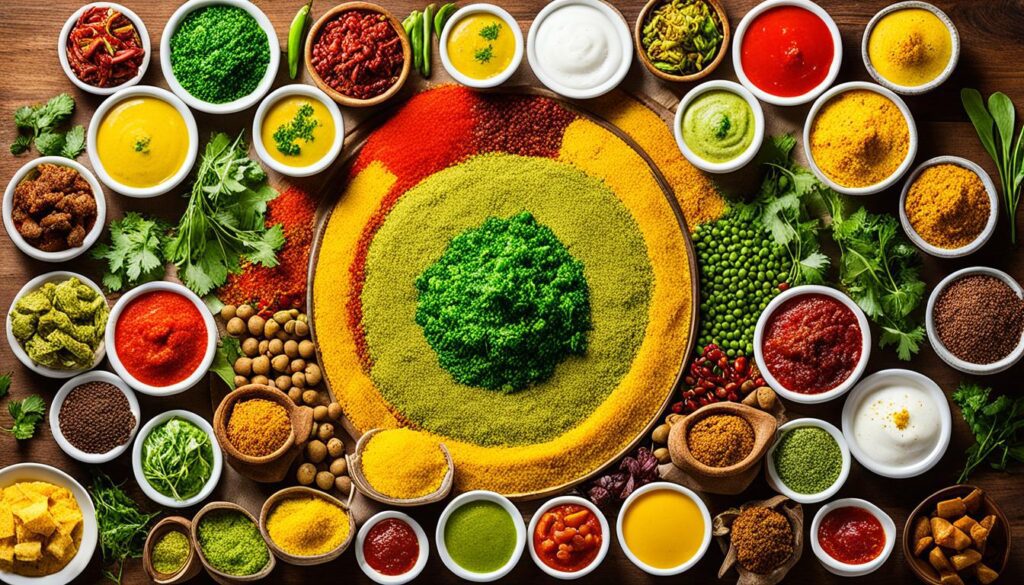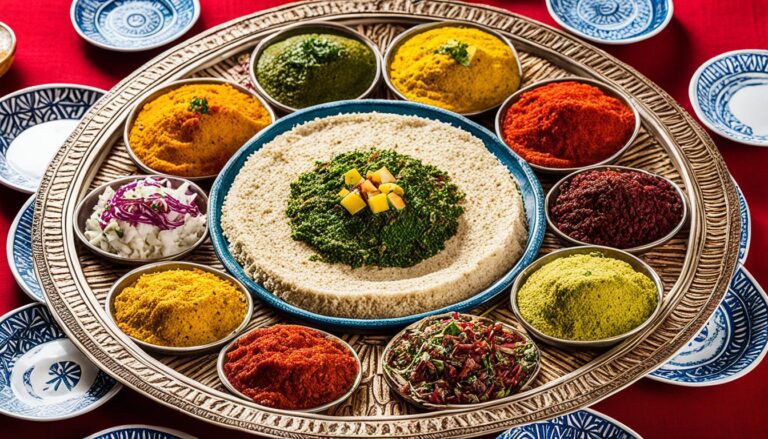Is Ethiopian Food High in Sodium?
Welcome to our exploration of Ethiopian cuisine! Today, we’re diving into the fascinating world of Ethiopian food and uncovering the truth about its sodium content. Are you curious whether this flavorful cuisine is high in sodium? The answer may surprise you. Let’s dig in!
Ethiopian food is known for its rich flavors, vibrant colors, and communal dining experience. But when it comes to sodium, is this cuisine a hidden culprit or a healthy choice? Join us as we unravel the mysteries and uncover the truth about Ethiopian food’s sodium content.
Key Takeaways:
- Discover the sodium levels in various Ethiopian dishes.
- Uncover traditional Ethiopian flavors and ingredients.
- Understand the health implications of consuming high-sodium foods.
- Explore strategies for maintaining a balanced sodium intake while enjoying Ethiopian cuisine.
- Learn about popular low-sodium Ethiopian dishes and how to prepare them at home.
Understanding Ethiopian Cuisine
Before we dive into the sodium content, let’s take a closer look at the unique flavors and ingredients that make up Ethiopian cuisine. Ethiopian cuisine is known for its rich and diverse flavors, as well as its use of traditional dishes that have been passed down through generations.
One of the most iconic dishes in Ethiopian cuisine is injera, a sourdough flatbread made from teff flour. It serves as the base for many Ethiopian meals and is traditionally eaten with various stews, known as wats. These wats are usually made with a combination of meats, legumes, and vegetables, cooked with aromatic spices such as berbere, a complex blend of chili peppers, garlic, ginger, and other spices.
Another popular dish is doro wat, a spicy chicken stew infused with flavorful spices and served with injera or rice. Tibs, which are sautéed or grilled meat dishes, are also common in Ethiopian cuisine. Vegetarians and vegans will find plenty of options too, with dishes like misir wat, a spicy red lentil stew, and shiro, a flavorful chickpea or lentil stew.
One unique aspect of Ethiopian cuisine is the concept of the communal meal. Injera serves as the plate, and various dishes are placed on top to be shared among diners. This communal dining experience not only fosters a sense of togetherness but also allows for the exploration of different flavors and textures.
Flavor Profiles
Ethiopian cuisine offers a wide range of flavor profiles that are sure to please any palate. The dishes are known for their bold and robust flavors, often combining spices, herbs, and aromatics to create a harmonious balance of taste sensations.
Some common flavors found in Ethiopian cuisine include spiciness from chili peppers and pepper blends like berbere, earthiness from aromatic spices such as cumin and cardamom, and tanginess from the use of fermented ingredients like injera. Additionally, the liberal use of garlic and ginger adds layers of depth and complexity to the dishes.
Whether you prefer mild or spicy, vegetarian or meat-based, Ethiopian cuisine offers a plethora of options that are sure to satisfy even the most discerning taste buds.
Sodium in Ethiopian Food
In this section, we will delve into the sodium levels found in various Ethiopian dishes. It’s important to understand the amount of sodium present in the food we consume, as excessive intake can have negative effects on our health. By exploring the sodium content of Ethiopian cuisine, we can make informed decisions about our dietary choices.
Ethiopian dishes are known for their rich flavors and vibrant spices. However, some of these flavor enhancers can also contribute to higher sodium levels. Ingredients like berbere, a traditional Ethiopian spice blend, may contain salt as a primary component, potentially increasing the overall sodium content of certain dishes.
Additionally, Ethiopian cuisine often utilizes a fermented bread called injera as a staple accompaniment. While injera itself is relatively low in sodium, it is often served with stews or sautéed vegetables that may contain higher levels of salt.
On the other hand, Ethiopian cooking also incorporates a wide variety of fresh vegetables, legumes, and grains. These ingredients tend to be naturally lower in sodium and can provide a balance to the overall sodium levels in the cuisine.

When it comes to cooking methods, traditional Ethiopian dishes are often slow-cooked or simmered for extended periods. This allows the flavors to develop and intensify. However, it can also result in an increase in sodium concentration as the liquid evaporates, leaving behind a higher concentration of salt.
It’s worth noting that the sodium levels in Ethiopian food can vary depending on the specific recipe and the cook’s preferences. By being mindful of the ingredients used and making conscious choices, it is possible to enjoy the delicious flavors of Ethiopian cuisine while managing sodium intake.
In the next section, we will discuss the health considerations associated with consuming high-sodium foods. We will explore the recommended daily sodium intake and the potential risks of excessive sodium consumption.
Health Considerations
When it comes to maintaining a healthy lifestyle, monitoring our sodium intake is crucial. Excessive sodium consumption can have adverse effects on our overall health, including increased risk of high blood pressure, heart disease, and stroke.
To ensure we are mindful of our sodium intake, it’s important to understand the recommended daily limits. According to the American Heart Association, individuals should aim to consume no more than 2,300 milligrams of sodium per day. However, for those with high blood pressure, the limit is even lower, at 1,500 milligrams per day.
Given the potential risks associated with excessive sodium consumption, it’s essential to be aware of the sodium levels in our food choices. It’s particularly important for individuals who are already diagnosed with health conditions like hypertension or cardiovascular disease.
By making informed decisions and opting for lower-sodium options, we can take a proactive approach to protect our health. And when it comes to enjoying Ethiopian cuisine, there are strategies we can implement to balance our sodium intake without sacrificing flavor.
Next, we’ll explore ways to maintain a balanced diet while still savoring the delicious flavors of Ethiopian food. We’ll share tips on making healthier choices and highlight popular low-sodium Ethiopian dishes that are both nutritious and flavorful.
Balancing Sodium Intake
In our quest for healthy eating, it’s important to find ways to enjoy Ethiopian food while keeping our sodium intake in check. The good news is that there are plenty of low-sodium options available that still pack a flavorful punch!
When dining out or ordering takeout, one strategy is to opt for dishes that are naturally lower in sodium. Look for options that feature fresh vegetables, lean proteins, and minimal added sauces or seasonings. You can also request for less salt or sauces on the side so you can control the amount you consume.
If you prefer cooking at home, you have even more control over your sodium intake. Experiment with traditional Ethiopian spices and herbs to enhance the flavor of your dishes without relying heavily on salt. Additionally, try substituting high-sodium ingredients with healthier alternatives. For example, instead of using regular table salt, use herbs and spices like turmeric, paprika, and garlic powder to add depth to your meals.
Remember: part of the appeal of Ethiopian cuisine lies in the communal eating experience, where injera (a type of flatbread) is used to scoop up various dishes. You can still enjoy this traditional practice while reducing sodium by focusing on the lower-sodium options available and keeping portion sizes in check.

By making mindful choices and exploring low-sodium options, you can enjoy the vibrant flavors and unique culinary experience of Ethiopian food while supporting your overall health and well-being.
Popular Low-Sodium Ethiopian Dishes
When it comes to Ethiopian cuisine, flavorful options can be found even in low-sodium recipes. We’ve curated a list of popular Ethiopian dishes that not only pack a punch in terms of taste but also keep sodium levels in check. Whether you’re looking to explore the vibrant flavors of Ethiopian food or wanting to incorporate healthier options into your diet, these dishes are sure to satisfy your cravings without compromising on taste.
1. Injera with Legume Stew
Start your low-sodium Ethiopian culinary journey with the quintessential dish, Injera, paired with a flavorful legume stew. Injera, a spongy fermented flatbread made from teff flour, is a staple in Ethiopian cuisine. Its tangy and slightly sour taste complements the hearty legume stew, which can be made using lentils, chickpeas, or split peas as the main protein source. This dish is a nutritious and delicious way to experience authentic Ethiopian flavors.
2. Gomen Wat
Gomen Wat is a classic Ethiopian dish made with collard greens simmered in a flavorful spice blend known as berbere. This aromatic and mild stew is low in sodium while still delivering a rich and satisfying taste. Serve it with a side of injera or rice for a complete and nutritious meal.
3. Misir Wot
Misir Wot, or lentil stew, is a staple in Ethiopian cuisine. Made by simmering red lentils in a thick, spicy sauce made from berbere and other aromatic spices, this dish is high in protein and low in sodium. Enjoy it with a side of injera or steamed vegetables for a nutritious and satisfying meal.
4. Atkilt Wot
Atkilt Wot is a flavorful Ethiopian vegetable stew that combines various vegetables such as cabbage, carrots, potatoes, and green beans. Seasoned with aromatic spices, this low-sodium dish offers a vibrant medley of flavors and colors. Serve it alongside injera or as a side dish to enhance your Ethiopian dining experience.
Explore these popular low-sodium Ethiopian dishes and savor the unique flavors of Ethiopian cuisine without worrying about excessive sodium intake. With a variety of nutritious and delicious options to choose from, you can enjoy Ethiopian food while maintaining a balanced and healthy diet.
Conclusion
In conclusion, Ethiopian food offers a wide range of flavors and dishes, each with its own sodium content. While some traditional Ethiopian dishes can be higher in sodium, there are also plenty of delicious low-sodium options available. By being mindful of the sodium levels and making informed choices when selecting your meals, you can enjoy the diverse and rich flavors of Ethiopian cuisine as part of a healthy diet.
It’s important to note that excessive sodium intake can have negative health implications, such as increased blood pressure and the risk of heart disease. However, by understanding the sodium content in Ethiopian dishes and considering low-sodium alternatives, you can still taste the vibrant spices and distinctive flavors while staying within a healthy sodium intake limit.
When dining out at an Ethiopian restaurant or preparing Ethiopian dishes at home, consider opting for dishes that use less salt or have low-sodium ingredients. This can include vegetable-based dishes like lentils and collard greens, which are nutritious and flavorful. Additionally, using herbs and spices like turmeric, ginger, and garlic can elevate the taste of your food without relying on excessive salt.
By making informed choices and exploring the diverse culinary traditions of Ethiopian cuisine, you can enjoy a delicious and varied dining experience while keeping your sodium intake in check. So go ahead, savor the flavors of Ethiopian food and embark on a culinary adventure that delights your taste buds and supports your overall health.






